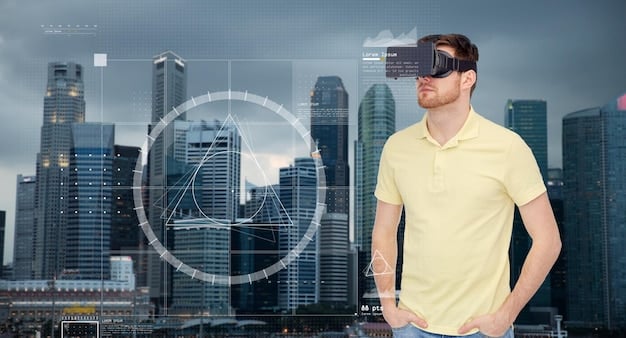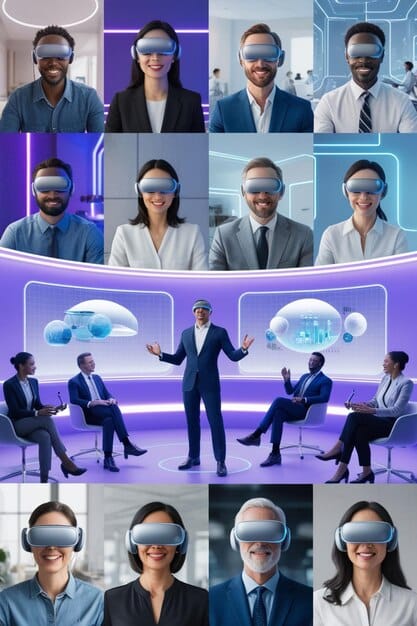The Metaverse in 2025: Real Growth or Just Hype?

The Metaverse in 2025 is poised for significant growth, driven by advancements in VR/AR technology, blockchain integration, and increasing adoption across industries like gaming, entertainment, and commerce, suggesting that it’s more than just hype.
Is the metaverse just a passing fad, or is it truly the next frontier of digital interaction? As we look ahead to 2025, the question of whether the Metaverse in 2025: Is the Hype Justified, or Are We Seeing Real Growth? becomes increasingly pertinent.
Understanding the Metaverse: A Quick Recap
Before diving into predictions for 2025, it’s crucial to understand what the metaverse is. In essence, it’s a persistent, shared, 3D virtual world (or worlds) that users can access through various devices, including VR headsets, AR glasses, and even traditional computers and smartphones.
The metaverse aims to replicate many aspects of our physical lives, allowing users to socialize, work, play games, shop, and even create and trade virtual assets.
Key Characteristics of the Metaverse
Several characteristics define the metaverse and differentiate it from typical online experiences.
- Persistence: The metaverse doesn’t stop when you log off. It continues to exist and evolve, regardless of individual user activity.
- Interactivity: Users can interact with each other and the virtual environment in real-time.
- Decentralization: Many envision the metaverse as a decentralized space, built on blockchain technology, empowering users with ownership and control over their data and assets.
- Economy: The metaverse includes a virtual economy where users can create, buy, sell, and trade digital goods and services.
Understanding these core concepts is essential for evaluating the potential and realistic outlook for the metaverse in 2025 as opposed to overblown expectations.
Technological Advancements Driving Metaverse Growth
Several key technological advancements are fueling the growth of the metaverse. These technologies are maturing rapidly, paving the way for more immersive and engaging virtual experiences.
Advancements in VR/AR headsets, blockchain, 5G connectivity, AI, and digital twins are expanding possibilities within the metaverse and are essential for a meaningful discussion about the Metaverse in 2025: Is the Hype Justified, or Are We Seeing Real Growth?

VR/AR Technology Leap
The quality and affordability of VR/AR headsets are steadily improving. Higher resolution displays, wider fields of view, and more comfortable designs are making virtual experiences more immersive and accessible.
Developments like eye-tracking, hand-tracking, and haptic feedback are further enhancing the sense of presence and realism within the metaverse.
Blockchain and NFTs
Blockchain technology provides a secure and transparent foundation for virtual economies within the metaverse. Non-fungible tokens (NFTs) enable users to own and trade digital assets, from virtual land to in-game items.
This ownership empowers creators and users, fostering a thriving ecosystem around digital content and experiences.
These technologies are critical to the long-term success of the metaverse and the Metaverse in 2025: Is the Hype Justified, or Are We Seeing Real Growth?
Adoption Across Different Industries
The metaverse’s potential extends far beyond gaming and entertainment. Several industries are exploring and adopting metaverse technologies to enhance their operations, customer engagement, and product development.
Gaming, retail, healthcare, education, manufacturing, and real estate are just some of the early adopters that are expected to bring the metaverse to a broader consumer base by 2025.
- Gaming: The gaming industry is leading the charge, with metaverse experiences like virtual concerts, in-game NFTs, and persistent virtual worlds.
- Retail: Retailers are creating virtual stores and showrooms to allow customers to browse and try products virtually.
- Healthcare: Metaverse applications in healthcare include virtual training simulations for surgeons, remote patient monitoring, and virtual therapy sessions.
- Education: Educational institutions are using the metaverse to create immersive learning environments, allowing students to explore historical sites, conduct virtual experiments, and collaborate with peers from around the world.
A broader adoption of the technologies is critical to determining if the Metaverse in 2025: Is the Hype Justified, or Are We Seeing Real Growth?
Challenges and Obstacles to Widespread Adoption
Despite the significant potential and advancements being made, there are still challenges to overcome before the metaverse achieves widespread adoption.
Technical limitations, accessibility issues, privacy and security concerns, and a lack of clear regulatory frameworks all pose significant hurdles to wider adoption.
Technical Limitations
Current VR/AR technology still faces limitations in terms of processing power, battery life, and network bandwidth. High-fidelity graphics and immersive experiences require significant computational resources, which can strain existing hardware and infrastructure.
Accessibility and Digital Divide
The cost of VR/AR headsets and high-speed internet access can create a digital divide, excluding individuals and communities from participating in the metaverse. Addressing these accessibility issues is crucial for ensuring inclusivity.
Privacy and Security Concerns
The metaverse raises significant privacy and security concerns, as users share vast amounts of personal data within virtual environments. Robust data protection measures and clear guidelines are needed to safeguard user privacy and prevent malicious activity.
The addressing of those hurdles is important to the discussion around the Metaverse in 2025: Is the Hype Justified, or Are We Seeing Real Growth?
Metaverse Predictions for 2025
Based on current trends and technological advancements, we can forecast a few likely scenarios for the metaverse in 2025.
Increased user adoption, cross-platform operability, a growing virtual economy, and more regulatory clarity will be critical hallmarks to observe to determine if the Metaverse in 2025: Is the Hype Justified, or Are We Seeing Real Growth?

Increased User Adoption
We can expect to see a significant increase in the number of users actively participating in the metaverse. As technology improves and prices come down, more people will be able to access and engage with virtual experiences.
Cross-Platform Interoperability
One of the key challenges for the metaverse is the lack of interoperability between different platforms and virtual worlds. In 2025, we may see progress towards greater interoperability, allowing users to seamlessly move their avatars and assets between different environments.
Growing Virtual Economy
The virtual economy within the metaverse is expected to continue growing rapidly. NFTs, virtual real estate, and in-game assets will become increasingly valuable, creating new opportunities for creators and entrepreneurs.
More Regulatory Clarity
As the metaverse becomes more mainstream, governments and regulatory bodies will begin to establish clear frameworks for governing virtual activities. This may include regulations related to data privacy, intellectual property, and consumer protection.
These evolutions are key to an answer to the question around the Metaverse in 2025: Is the Hype Justified, or Are We Seeing Real Growth?
The Future of Work in the Metaverse
The metaverse has the potential to transform the future of work, offering new possibilities for collaboration, remote work, and employee training.
Virtual meetings, collaborative workspaces, remote mentorship, virtual training, and recruitment are just some of the opportunities brought by the metaverse to the future of work.
Virtual Meetings and Collaboration
Virtual meetings in the metaverse will become more immersive and engaging, allowing participants to interact with each other in a realistic 3D environment. Collaborative workspaces in the metaverse will enable teams to work together on projects as if they were in the same physical location.
Remote Mentorship and Training
The metaverse can also facilitate mentorship programs, connecting experienced professionals with younger colleagues in a virtual environment. Virtual training simulations can provide employees with hands-on experience in a safe and controlled setting.
Recruitment and Employer Branding
- The metaverse can revolutionize the recruitment process, allowing companies to showcase their culture and values to potential candidates in an immersive way.
- Virtual job fairs and onboarding experiences can attract top talent and create a sense of belonging for new employees.
However, there are challenges to overcome to confirm if the Metaverse in 2025: Is the Hype Justified, or Are We Seeing Real Growth? in respect to the future of work.
| Key Aspect | Brief Description |
|---|---|
| 🚀 Tech Advancements | VR/AR, blockchain, and 5G driving immersive experiences. |
| 💼 Industry Adoption | Gaming, retail, healthcare increasingly utilizing metaverse. |
| 🔒 Challenges | Accessibility, privacy, and infrastructure hurdles remain. |
| 🌐 Future of Work | Virtual meetings, training, and recruitment are transforming work. |
Frequently Asked Questions
▼
The metaverse is a persistent, shared virtual world accessible via various devices, where users can interact, work, play, and transact much like in the real world.
▼
Key technologies include VR/AR for immersive experiences, blockchain for secure transactions and ownership, and 5G for fast, reliable connectivity.
▼
Gaming, retail, healthcare, education, and manufacturing are among the early adopters, each finding unique applications for virtual environments.
▼
Challenges include accessibility issues, privacy and security concerns, technical limitations, and the need for clear regulatory frameworks.
▼
The metaverse can transform collaboration, remote work, training, and recruitment, offering immersive and effective solutions for the modern workforce.
Conclusion
In conclusion, while some initial hype surrounding the metaverse may have been overstated, significant technological advancements, industry adoption, and user growth indicate that it is evolving into a substantial component of our digital future. By 2025, it’s likely the metaverse will be a more integrated and accessible part of our daily lives, though challenges related to accessibility, security, and regulation require careful attention.





